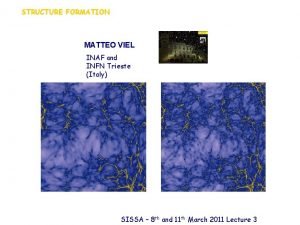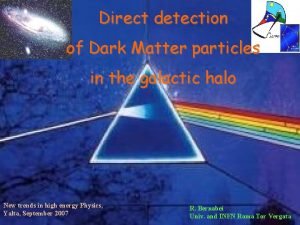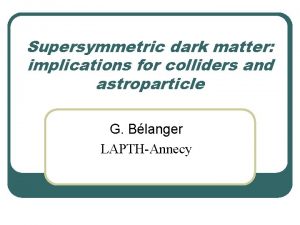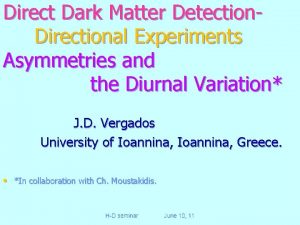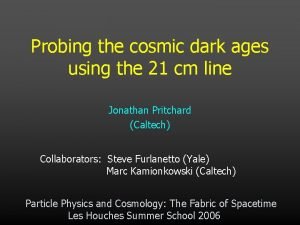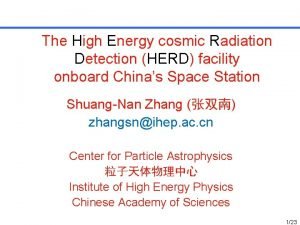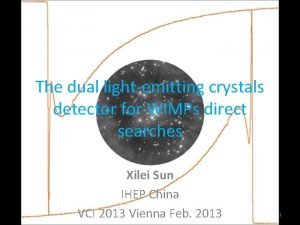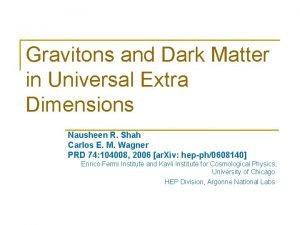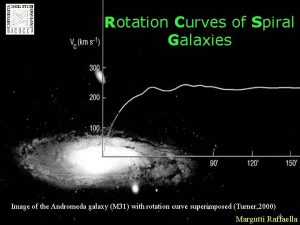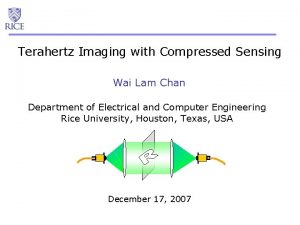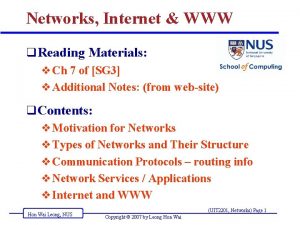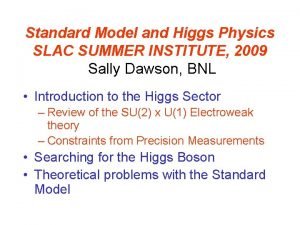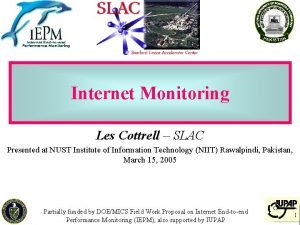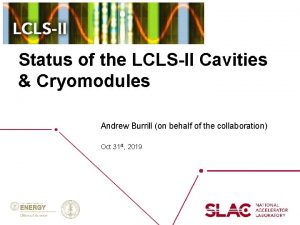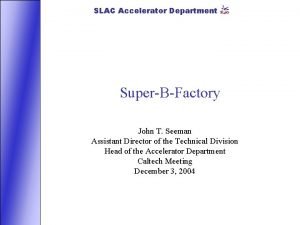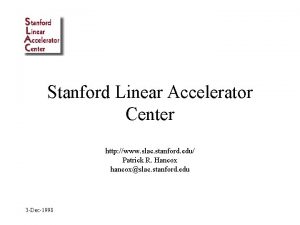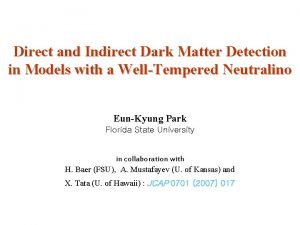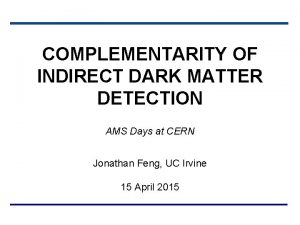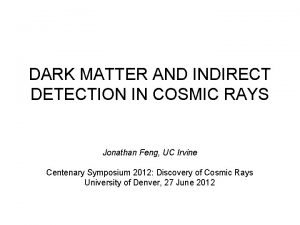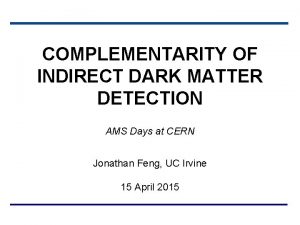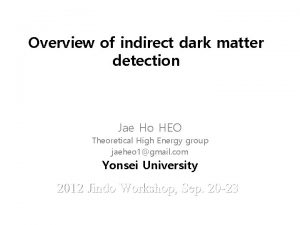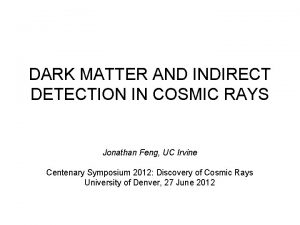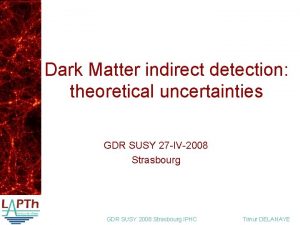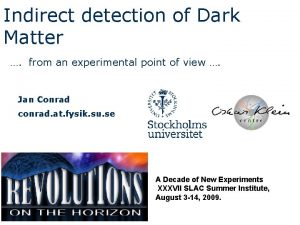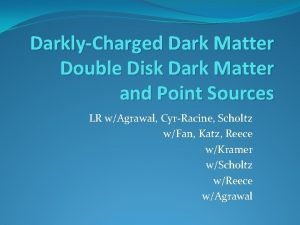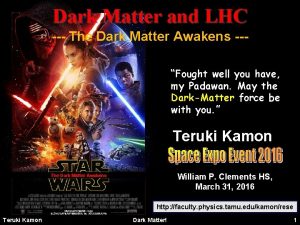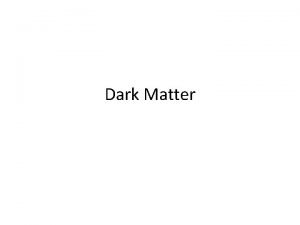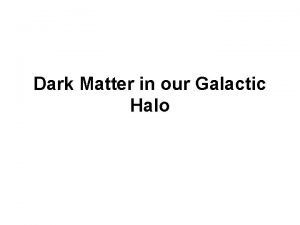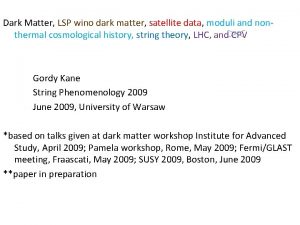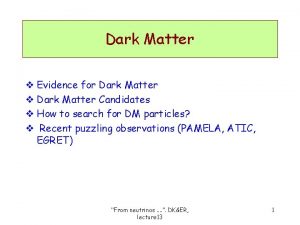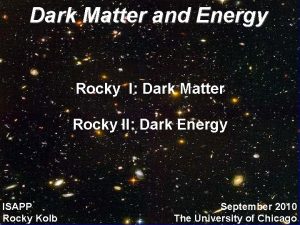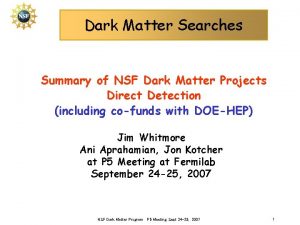Indirect detection of dark matter Larry Wai SLAC






























- Slides: 30

Indirect detection of dark matter Larry Wai SLAC July 21, 2006 - VLCW 06 Cosmology Session Larry Wai / SLAC

Indirect detection – a complementary way to observe dark matter signals! DM Experiment Class Dark matter source location Dark matter interaction Direct Detection Earth’s Surface WIMP-nucleus scattering Particle Beam Collider Irrelevant WIMP pair production Indirect Detection Earth, Sun, Galaxy, extragalactic July 21, 2006 - VLCW 06 Cosmology Session Larry Wai / SLAC WIMP pair annihilation 2

Particles used for indirect detection of dark matter WIMP pair annihilation hadronic final states time c c W-/Z/q _ W+/Z /q p 0 } nm p+ p- nm ne m+ nm m- e+ nm ne e+ a few p/p, d/d July 21, 2006 - VLCW 06 Cosmology Session Larry Wai / SLAC 3

Particles used for indirect detection of dark matter WIMP pair annihilation leptonic final states c c time n/e-/m-/t- n/e+/m+/t+ July 21, 2006 - VLCW 06 Cosmology Session } m/t- p 0 nm/tne e- or t- nt p- m/t+ nm/tne nm nm ne m- e- e+ Larry Wai / SLAC 4

Particle yields & spectra Gamma ray yield per final state bb WIMP pair annihilation gamma spectrum July 21, 2006 - VLCW 06 Cosmology Session MWIMP Total# >100 Me. V >1 Ge. V >10 Ge. V 10 Ge. V 17. 3 12. 6 1. 0 0 100 Ge. V 24. 5 22. 5 12. 4 1. 0 1 Te. V 31. 0 29. 3 22. 4 12. 3 200 Ge. V mass WIMP Larry Wai / SLAC 5

Spectral lines time Ø For lines, energy = WIMP mass; branching fraction is suppressed c Ø e+e-, nn lines are possible at tree level (especially for Dirac fermion or boson WIMPs) c Ø For WIMP masses > MZ /2 can also have Z 0 line , e+, n ? , e-, n γ c ? Ø Measurement of line branching fractions would constrain particle theory July 21, 2006 - VLCW 06 Cosmology Session Larry Wai / SLAC c Z 0 6

Annihilation flux spectrum ∫(∑id. N/d. E Bi)d. E (particle physics) x x 2 number density 2 2 2 4 p ∫r (r)r dr / M WIMP (astrophysics) x x ann. cross-section <sn> / 2 (cosmology, particle physics) x x 1/4 pd 2 distance-2 July 21, 2006 - VLCW 06 Cosmology Session Larry Wai / SLAC 7

Where should we look for indirect signals? • • • Galactic satellites Galactic halo Extra-galactic Galactic center Stars July 21, 2006 - VLCW 06 Cosmology Session Larry Wai / SLAC 8

Current experiments Gamma ray detectors • Space (20 Me. V-300 Ge. V) Ø GLAST Neutrino detectors • Underground (>5 Me. V) Ø Super-Kamiokande • Undersea / ice (>5 Ge. V) • Ground (>100 Ge. V) Ø VERITAS Ø HESS Ø MAGIC July 21, 2006 - VLCW 06 Cosmology Session Ø AMANDA/ ICECUBE Ø ANTARES Anti-Matter detectors • Space Ø PAMELA Ø AMS Larry Wai / SLAC 9

~ 10 km 1. 8 m Particle Shower effective area ~ 4 x 105 m 2 field of view~0. 01 sq. rad. particle bkgd<100 Ge. V s. E~15% 1. 0 m e+ e– 565 km altitude effective area ~ 1 m 2 field of view~2. 5 sq. rad. particle bkgd<100 Me. V s. E~10% (E>100 Me. V) ~ 100 m July 21, 2006 - VLCW 06 Cosmology Session Larry Wai / SLAC 10

Gamma Ray Detectors MAGIC GLAST Ship to SASS in Sept. 2006 Launch in Sept. 2007! 2 nd large telescope in late 2007 VERITAS HESS 5 th telescope in early 2008 4 telescopes in 2007 July 21, 2006 - VLCW 06 Cosmology Session Larry Wai / SLAC 11

Diffuse gamma ray background EGRET E >1 Ge. V, point-source subtracted, Cillis & Hartman (2005) Modeling with GALPROP Inputs include matter distribution July 21, 2006 - VLCW 06 Cosmology Session Larry Wai / SLAC 12

Example A. dark matter satellite 55 -days GLAST in-orbit counts map (E>1 Ge. V) Galactic Center Optimistic case: 70 counts signal, 43 counts background within 1. 5 deg of clump center July 21, 2006 - VLCW 06 Cosmology Session 30 -deg latitude Larry Wai / SLAC 13

Dark matter source spectrum GLAST 55 days (10 -sigma) Dark matter spectrum Diffuse background E-2. 6 spectrum July 21, 2006 - VLCW 06 Cosmology Session Larry Wai / SLAC 14

How many observable dark matter sources? LSP WIMP (SUSY) GLAST 5 -yrs LCC 2 LCC 4 July 21, 2006 - VLCW 06 Cosmology Session Larry Wai / SLAC Simulation of Milky Way dark matter satellites from Taylor & Babul (2004, 2005) SUSY model definitions from Baltz, et. al. (2006); LCC 2 and LCC 4 are favorable to GLAST compared to LCC 1 and LCC 3. 15

Example: GLAST-IACT search strategy • Assume GLAST finds some high latitude dark matter point sources consistent with WIMP mass ~100 Ge. V • Assume IACTs learn how to eliminate all of the charged particle background <150 Ge. V while retaining 20% gamma efficiency Ø Example: 10 -sigma high latitude GLAST WIMP source (5 -yr exposure) would have ~100 counts background (0. 5 -deg radius circle, E>1 Ge. V), ~100 counts signal; follow-up by IACT would have ~40 line gammas for a line branching fraction ~. 003. The IACT extragalactic gamma background would be ~60 (100 Ge. V mass WIMP). July 21, 2006 - VLCW 06 Cosmology Session Larry Wai / SLAC 16

Example B. Milky Way dark matter halo EGRET E >1 Ge. V, point-source subtracted, Cillis & Hartman (2005) High latitude Region Disk Region Center Region Disk Region High latitude Region July 21, 2006 - VLCW 06 Cosmology Session Larry Wai / SLAC WIMP search “sweet spot” (Stoehr et. al. 2004) 17

EGRET diffuse “Ge. V excess” -still up for grabs! Hunter et al (1997); similar “Ge. V excess” in all sky regions EGRET Instrumental effects |b|<10 deg, |l|<60 deg ØNeed to include diffractive pp->p 0 cross-section; Kamae (2005) ØCan be explained with astrophysical mechanisms; i. e. SMR (2004) ØDe Boer has claimed WIMP annihilation; i. e. De Boer, et. al. (2005) ØScenarios can be tested with anti-matter fluxes; i. e. Edsjo (2006) July 21, 2006 - VLCW 06 Cosmology Session Larry Wai / SLAC 18

Back-of-the-envelope line significance • Consider high latitude region |b|>10 deg (|b|>30 deg for |l|<30 deg), 5 years GLAST on -orbit • line background is flux within DE/E=0. 235 at MWIMP, Z line Ø Assume WIMP continuum is 30% of galactic diffuse flux for E>. 01 MWIMP Ø Assume 0. 1% branching fraction to line Ø # sigma is no. line counts/sqrt(no. bkgd counts) July 21, 2006 - VLCW 06 Cosmology Session Larry Wai / SLAC line Z line 19

Example C: Galactic Center EGRET GLAST Mayer-Hasselwander (1998) - EGRET point source Spatial analysis • 100 Me. V-300 Me. V (l ~ -0. 75 deg) HESS Cesarini, (2004)Fucito, Lionetto, Morselli, Ullio (2003) • 300 Me. V-1 Ge. V (l ~ -0. 30 deg) • > 1 Ge. V (l ~ 0. 05 deg) 95% CL CL • > 5 Ge. V (l ~ 0. 20 deg) Hooper & Dingus (2004) x New diffuse component in the galactic center region, HESS (2006) Galactic Center Hooper and Dingus (2002) July 21, 2006 - VLCW 06 Cosmology Session Larry Wai / SLAC Mayer-Hasselwander et. al. (1998) 20

Galactic center m. SUGRA sensitivity: small tan(b) regime (5 s) Ø Ø July 21, 2006 - VLCW 06 Cosmology Session See Baltz, et. al. (2006) for definition of LCC 2. Note: position of this point is very sensitive to mt and this placement estimates the equivalent LCC 2. Accelerator limits are from H. Baer, et al. (2004) Larry Wai / SLAC 21

Galactic center m. SUGRA sensitivity: large tan(b) regime Ø (5 s) July 21, 2006 - VLCW 06 Cosmology Session Ø See Baltz, et. al. (2006) for definition of LCC 4. Note: position of this point is very sensitive to mt and this placement estimates the equivalent LCC 4. Accelerator limits are from H. Baer, et al. (2004) Larry Wai / SLAC 22

Dark matter neutrino detection technique July 21, 2006 - VLCW 06 Cosmology Session Larry Wai / SLAC 23

Neutrino detectors Super-Kamiokande Feb. 2006 9 strings (80 by 2011) July 21, 2006 - VLCW 06 Cosmology Session Larry Wai / SLAC ANTARES Feb. 2006 – 1 line (12 lines by 2007) 24

Solar WIMP sensitivity July 21, 2006 - VLCW 06 Cosmology Session Larry Wai / SLAC 25

dark matter anti-matter sources Galactic Center / Halo Dark matter source Earth anti-proton, positron ~3 kpc galactic magnetic field scale height July 21, 2006 - VLCW 06 Cosmology Session Larry Wai / SLAC 8. 5 kpc 26

Anti-matter detectors PAMELA July 21, 2006 - VLCW 06 Cosmology Session Larry Wai / SLAC AMS-1 27

Dark matter anti-matter spectra 336 Ge. V mass WIMP July 21, 2006 - VLCW 06 Cosmology Session Larry Wai / SLAC GALPROP background estimate 28

Future of indirect detection Impact of new information • Direct detection results on cross-section will impact expected neutrino flux from solar WIMP accumulation • WIMP mass measurements (from direct, LHC, GLAST? ) will impact expected annihilation spectrum; i. e. what threshold do we need for IACT line measurements? • Location of WIMP annihilation sources by GLAST would dramatically alter the landscape; i. e. tell IACTs where to look! July 21, 2006 - VLCW 06 Cosmology Session Indirect experiments • ICECUBE, PAMELA, AMS-2 – discovery potential for large mass, large lepton branching fraction scenarios • GLAST, IACTs, & Beyond VERITAS – accurate line branching fraction measurements would constrain particle theory Larry Wai / SLAC 29

Indirect detection summary Search regions: Øgalactic center Øgalactic satellites Øgalactic halo Øextragalactic Øthe sun, earth July 21, 2006 - VLCW 06 Cosmology Session Goals: Ø Observe particle nature of dark matter Ø Measure WIMP mass Ø Constrain leptonic branching fractions Ø Measure line branching fractions Larry Wai / SLAC 30
 Dark matter and dark energy presentation
Dark matter and dark energy presentation In the dark dark town
In the dark dark town Dark matter
Dark matter Boosted dark matter
Boosted dark matter Where to stream dark matter
Where to stream dark matter Dark matter
Dark matter Dark matter
Dark matter What could dark matter be
What could dark matter be Les houches dark matter
Les houches dark matter Dark matter pwo
Dark matter pwo Dark matter
Dark matter Matter gravitons other dimensions
Matter gravitons other dimensions Dark matter physics
Dark matter physics ютуб
ютуб Francis b wai
Francis b wai Dr wai lee
Dr wai lee When was new zealand discovered
When was new zealand discovered Qun hong chan
Qun hong chan Chu ni yi wai
Chu ni yi wai Mindful smelling
Mindful smelling Dr lee chi wai
Dr lee chi wai Ko wai koe no hea koe
Ko wai koe no hea koe Magic lam
Magic lam Dr wai-lam chan
Dr wai-lam chan Leong hon wai
Leong hon wai Wai ling lam
Wai ling lam Slac summer institute
Slac summer institute Network data collection at slac
Network data collection at slac Andrew burrill slac
Andrew burrill slac Slac
Slac Stanford remote desktop
Stanford remote desktop


